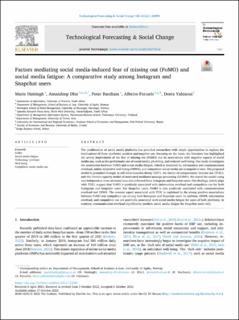| dc.contributor.author | Hattingh, Marie | |
| dc.contributor.author | Dhir, Amandeep | |
| dc.contributor.author | Ractham, Peter | |
| dc.contributor.author | Ferraris, Alberto | |
| dc.contributor.author | Yahiaoui, Dorra | |
| dc.date.accessioned | 2023-04-03T10:21:03Z | |
| dc.date.available | 2023-04-03T10:21:03Z | |
| dc.date.created | 2022-11-02T07:10:49Z | |
| dc.date.issued | 2022 | |
| dc.identifier.citation | Hattingh, M., Dhir, A., Ractham, P., Ferraris, A., & Yahiaoui, D. (2022). Factors mediating social media-induced fear of missing out (FoMO) and social media fatigue: A comparative study among Instagram and Snapchat users. Technological Forecasting and Social Change, 185, 122099. | en_US |
| dc.identifier.issn | 0040-1625 | |
| dc.identifier.uri | https://hdl.handle.net/11250/3061757 | |
| dc.description.abstract | The proliferation of social media platforms has provided researchers with ample opportunities to explore the implications of these platforms' positive and negative use. Focusing on the latter, the literature has highlighted the severe implications of the fear of missing out (FoMO) and its associations with negative aspects of social media use, such as the problematic use of social media, phubbing, and reduced well-being. Our study investigates the association between FoMO and social media fatigue, which is mediated by information and communication overload, online subjective well-being (OSWB), and compulsive social media use (compulsive use). The proposed model is grounded strongly in self-determination theory (SDT), the theory of compensatory Internet use (TCIU), and the limited-capacity model of motivated mediated message processing (LC4MP). We tested the model using two independent cross-sectional data sets collected from Instagram and Snapchat users. Our findings, which align with TCIU, suggest that FoMO is positively associated with information overload and compulsive use for both Instagram and Snapchat users. For Snapchat users, FoMO is also positively associated with communication overload and OSWB. The overuse aspect associated with TCIU is explained in the strong positive associations between FoMO and compulsive use among both Instagram and Snapchat users. In addition, OSWB, information overload, and compulsive use are positively associated with social media fatigue for users of both platforms. In contrast, communication overload significantly predicts social media fatigue for Snapchat users only. | en_US |
| dc.language.iso | eng | en_US |
| dc.publisher | Elsevier | en_US |
| dc.rights | Navngivelse 4.0 Internasjonal | * |
| dc.rights.uri | http://creativecommons.org/licenses/by/4.0/deed.no | * |
| dc.title | Factors mediating social media-induced fear of missing out (FoMO) and social media fatigue: A comparative study among Instagram and Snapchat users | en_US |
| dc.type | Peer reviewed | en_US |
| dc.type | Journal article | en_US |
| dc.description.version | publishedVersion | en_US |
| dc.rights.holder | The authors | en_US |
| dc.subject.nsi | VDP::Samfunnsvitenskap: 200 | en_US |
| dc.source.pagenumber | 1-14 | en_US |
| dc.source.volume | 185 | en_US |
| dc.source.journal | Technological Forecasting and Social Change | en_US |
| dc.identifier.doi | 10.1016/j.techfore.2022.122099 | |
| dc.identifier.cristin | 2067664 | |
| dc.source.articlenumber | 122099 | en_US |
| cristin.ispublished | true | |
| cristin.fulltext | original | |
| cristin.qualitycode | 1 | |

